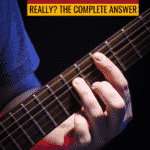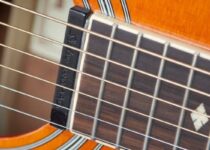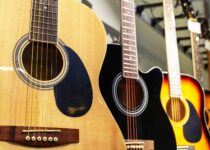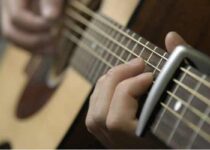How many guitar chords are there? While it may seem infinite, the answer is actually quite mathematical. The estimates vary, but considering only one octave, we can have 4083 possible chords! That’s 10 chord types across 12 musical notes, with different combinations of notes.
If that sounds confusing, bear with me. Every guitarist (beginner or pro) has likely wondered, “How many guitar chords can I really learn?”, at some point in his career. While it’s not possible to learn over four thousand chords, the theory behind it is easier than you think.
And that’s why we’ve put together this quick post to help you understand the math and music theory behind this staggering number, and how you can apply this in your own guitar playing.
Post Contents
Estimating the Number of Guitar Chords
So, how many guitar chords are there? Estimating the number of guitar chords is actually a bit of a challenge. It depends on the number of octaves we consider, the number of chord voicings, and whether or not we count for similar chords. Some chord variations can also be played in several ways, but we’re not going into that.
Without going into too much math and giving you a possible headache, let me simplify the numbers for you.
- Possible chord variations within one octave – 4083
- If we exclude power chords (2 notes) from there – 4017
- The playable chords out of these – 2341
Now it’s important to note that this is all in ONE octave. A guitar typically has four octaves, and a piano would have 7 octaves. If you consider the various octaves together, the possible chord combinations actually seem infinite.
While this is great mathematical fun, how much of this is musically relevant? And is this even necessary for a beginner guitarist to know? Most of the popular songs you love listening to were likely composed of just 4-5 chords. Well, let’s discuss.
Guitar Chords 101: What Are Major and Minor Chords?
If you’re a beginner, knowing the basics of guitar chords and chord shapes is a must. Even if you already know, here’s a refresher:
Chords are a combination of notes that have musical meaning. They’re usually derived from a scale, with the 1st, 3rd, and 5th notes of a scale forming a normal chord called a triad.
A chord made from a major scale (such as a C major chord) is a major chord, while one made from a minor scale (like A minor) is a minor chord (pretty obvious right?). Note that, while both the C Major and A Minor scales contain the same notes, the chords are different. This is where the fun begins.
By picking different notes from the same scale, you can come up with new chord combinations that have unique sounds and add more flavor to your music. The intervals between chords determine how they sound – happy (major) or sad (minor).
What Are The Types Of Guitar Chords?
There are 10 types of guitar chords in total. Let’s look at each one in brief.
Open Chords vs Barre Chords
Most beginners usually wonder, “What’s the difference between open chords and barre chords?” While it may seem like these are a ‘chord type’, they are actually just different ways of playing the same chord. So, to clarify, open chords and barre chords are not chord types.
In an open chord, at least one guitar string rings open, while in a barre chord you use your index finger to bar an entire fret (just like a capo).
Theoretically, there’s not much difference, but they do sound quite different. Open chords tend to sound brighter with more resonance and presence, as the notes sustain longer than barre chords.
Triads
We already discussed triads (the most basic chords), but let’s go into a bit more detail here with a few examples:
C Major (I) – C-E-G
F Major (IV) – F-A-C
A Minor (vi) – A-C-E
If you’re wondering what the Roman numeral system is, these are used in notation to indicate major and minor triads. The capital letter is for major chords, while the small letter indicates minor chords (i.e., ii or IV).
Power chords
Power chords are the simplest you could learn – they’re made of just 2 notes – the first and the fifth of any scale. For example, a C power chord is just C-G, and an A power chord is A-E.
They’re mostly used in rock and metal, because distortion brings out the harmonic characteristics of just these two notes, leading to a ‘powerful’ sound.
Diminished
“Oooh…they sound kinda scary!”
Diminished chords are quite popular in horror movie scores, and they certainly do sound ominous. They consist of tones 1, ♭3 (flat 3), and ♭5 (flat 5). These notes are also referred to as the root, minor third, and flat fifth. For example, A diminished triad is A-C-E♭ or just A-C♭-E.
Diminished chords are really useful, as demonstrated here:
Augmented
“What the heck is an augmented chord?” You may have asked yourself this when you first saw it in a notation or tab, but here’s what it looks like:
Augmented chords are typically used to add tension to the music. Every augmented chord has a major 3rd, but it also has an augmented 5th, which is what gives it that tense sound.
Diminished and augmented chords both have an odd sound because their notes create a dissonant interval between two notes.
But I’ll be honest with you here: getting into the nitty-gritty of diminished and augmented chords is a whole new world. You can add 7ths, 13ths, flatten a few notes, and find a lot of new sounds you’d never thought of. It’s complex, but rewarding too.
Equivalents
As you may have guessed, equivalents are chords that have the same notes. These chords can be in different keys, but they must also share the same notes. For example, C6 and Am7 are equivalent because both have the notes A-C-E-G, but in a different order.
They are not the same chord because their notes are not in the same order, and hence they resolve differently. This is also known as chord substitution, and it’s a great way to spice up a generic chord progression.
7th
As you can probably guess, these consist of at least four notes – they usually have a root (the first), the third, the fifth, and a seventh note.
7th chords are quite popular in jazz, and you can use them to add some nice texture to songs. Let’s take a look at the G7 chord:
It’s made up of the notes G-B-D-F. You can use seventh chords to form a three-chord progression. There are various types of 7th chords based on intervals, but we’ll leave that for now.
Suspended
Suspended chords are pretty similar to the 7th chord in that they usually have a perfect fourth note (sus4), or a major second (sus2). Let’s look at a Csus2 triad (C-D-G):
You can also have a suspended 7th chord by adding a minor 7th. Since suspended chords are neither minor nor major, they can be used in a wide variety of scenarios. They usually have an open, ‘hopeful’ tonality to them.
Extended
Extended chords are basically the next step up from 7th chords. These are your standard barre chord shapes, and they consist of notes 1-3-5-7-9 of any particular scale. You can go beyond and add the 11th or 13th notes too. Here’s an example with Cmaj7#11 (C-E-G-B-F#):
Extended chords are great for adding some color to a chord progression, but they do add some complexity. They’re often used in jazz, and surprisingly, progressive metal too.
Slash
Slash chords are commonly used in pop songs (Pink Floyd’s Wish You Were Here), and they’re really straightforward to play. Slash chords include a bass note that is often the root note followed by a slash and another note from the chord you’re playing over. Let’s see an example of D/F#:
In this example, the chord being played is a D major. That’s a pretty common chord to use as it sounds nice and has a great root note. However, what if you need it to sound fuller? That’s why we add the F# to it, which adds some thickness to the sound.
Altered
Altered chords take a normal diatonic chord, but swap out of one of the notes for a neighboring chromatic note instead. This creates dissonance and tension, and adds a whole new flavor to the sound. Let’s see an example with a D7 in the key of C:
Notice that we mentioned ‘the key of C’. This is because the root note is important in determining altered chords. A D7 normally is just a 7th chord, but with C as its root, it becomes altered as it doesn’t follow the diatonic chart.
Phew, that was a lot to take in if you’re a beginner. Here’s a video that showcases the various chord types:
What’s a Chord Progression?
A chord progression is just a series of chords played in succession, or one after the other. You can start with any chord – be it power chords, barre chords, open major chords, etc., and you can move to another by using a chord chart.
Here’s an interesting chord progression that uses 7th, extended, slash, and altered chords for a beautiful sound:
How Many Guitar Chords Should a Beginner Learn?
As I said before, even if you’re not a beginner, learning some of these chords can be beneficial because they might open up opportunities for you to compose music in weird and wonderful ways. But how many guitar chords should a beginner really learn? Should you learn ALL the chords?
It’s entirely up to you – the only reason why people don’t recommend learning as many chords as possible is that it can be overwhelming to learn all of them at once.
Pick what you think you’ll use the most, and focus on those first! You can start by learning just 4 or 5 chords that are commonly used in pop songs (C Major, G Major, D Minor…).
This way, instead of trying to learn everything, you can listen to songs and try to figure out what they’re playing. You may get stuck along the way, but that’s fine because you’ll be able to learn as you play.
Even though there are many types of guitar chords, don’t worry about all of them at once. Just focus on a few, and you’ll be able to play most songs with ease!
And when you feel confident, and you want to explore new musical possibilities, that’s when you should try learning the rare chord combinations. Use them to create unique chord progressions, and you may just surprise yourself!
Should you try to learn all the types of chords?
Whether you’re a beginner or a pro, the short answer is no! Most guitarists don’t even need to know all the types of chords, even after they become professionals. Why?
Chords vary a lot from genre to genre. For example, most pop songs could be played with just 4-5 chords, but genres like blues and jazz do require more chord variations. Jazz players usually do know a LOT of chord variations and jazz chords, but suffice to say; they still don’t memorize 4,000 chords!
On the other hand, you have rock and metal, where knowing just the power chords and triads may be good enough for most songs. Of course, there’s complexity in those too, but we’ll leave that for another day (Dream Theater reference, anyone?).
In most cases, guitarists experiment with what sounds good to their ears and play along. You may stumble upon a new chord, use it in a song, and then forget it after a few months. But it’s easy to pick it up again. So you can always relearn the chords you need, as you need them.
So, how many guitar chords are there that are actually relevant to your playing? That depends on the style of music that you play, but it’s nowhere close to the total number of possible ways to form a guitar chord.
Frequently Asked Questions About Guitar Chords
How many total guitar chords are there?
There are a total of 4083 guitar chords, if you only consider one octave. By considering multiple octaves, the number goes up exponentially!
What are the 12 chords of guitar?
The 12 chords of guitar all follow the musical notes – C, D, E, F, G, A, B + five flats and equivalent sharps in between. You have over 10 different types of chords for each note, so the combinations seem endless.
How many chords do most guitar players know?
Most guitar players only know a handful of chords that are needed to play their songs. Knowing a few dozen chords is handy enough for most players, as you can combine these to form hundreds of guitar chord progressions. As you gain experience, it’s easy to apply music theory and discover new chords on the fly!







